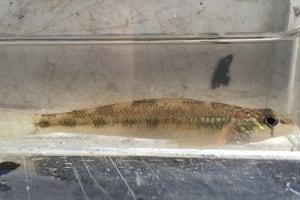River Darter
Scientific name: Percina shumardi
Cover photo credit: Jason Barnucz
Status
Endangered (Great Lakes - Upper St. Lawrence populations)
"Endangered" means the species lives in the wild in Ontario but is facing imminent extinction or extirpation.
Not at Risk (Saskatchewan - Nelson River populations and Southern Hudson Bay - James Bay populations)
These populations are "Not at Risk". This means that the populations are not endangered or threatened, and are not at risk of becoming threatened based on current biological knowledge and identified threats.
Date added to the Species at Risk in Ontario List
River Darter (Great Lakes – Upper St. Lawrence populations) – June 2, 2017
Read the assessment report (PDF)
What it looks like
The River Darter is a small and elongate member of the perch family that grows to between four and eight centimeters in length. It has a light brown to dark olive body with several distinct markings including seven to eight dark saddle patches on its back, eight to 15 lateral dark blotches on its side, a black tear-drop marking under its eye, and two well-defined spots on its first dorsal fin. Scientists distinguish the River Darter from other similar looking species (i.e. Channel Darter) by the presence of their dark dorsal spots. Colouration of breeding males is generally darker.
Where it lives
In Ontario, the River Darter lives in medium to large rivers and lakes with moderately fast current. Unlike many other darter species, the River Darter is tolerant of turbid conditions. It is typically found on gravel and cobble substrates in relatively deep water habitats. The River Darter is known to undertake seasonal migrations, moving upstream in the spring to spawn, and downstream in the fall. It eats a variety of food items including aquatic snails, fish eggs, and insect larvae.
Where it’s been found in Ontario
The River Darter is one of the most broadly distributed darter species and is found from the Gulf of Mexico north to the Nelson River, near Hudson Bay. However, it is generally not very abundant throughout its range. In Canada, the River Darter lives in Saskatchewan, Manitoba, and Ontario. In Ontario, it is found in several rivers and lakes of the Northwest as well as in a limited number of locations around the Great Lakes.
The Great Lakes-Upper St. Lawrence populations are only known from three locations; Lake St. Clair, and the Thames and Sydenham Rivers.
What threatens it
The threats impacting River Darter are not well understood. In the Great Lakes-Upper St. Lawrence area, the main threats to the River Darter are suspected to be invasive species, poor water quality, and habitat alteration. This species likes clean gravel and cobble habitats in deep water (less than 15 meters) with moderate flow and not do well in rivers and lakes that are polluted or have modified, hardened shorelines. Hardened shorelines can alter the nearshore habitat of rivers and lakes, potentially eliminating the clean gravel and cobble habitat preferred by this species. Invasive fish species that compete with the River Darter for food or habitat are also a threat.
Action we are taking
Endangered species and their general habitat are automatically protected.
Recovery strategy
A recovery strategy advises the ministry on ways to ensure healthy numbers of the species return to Ontario.
Read the executive summary and full document (May 30, 2018).
Government response statement
A government response statement outlines the actions the government intends to take or support to help recover the species.
Read the government response statement (February 28, 2019)
What you can do
Report a sighting
- The Ministry of Natural Resources and Forestry tracks species at risk such as the River Darter. You can use a handy online form to report a sighting to the Natural Heritage Information Centre. Photographs with specific locations or mapping coordinates are always helpful.
Volunteer
- Volunteer with your local nature club or provincial park to participate in surveys or stewardship work focused on species at risk.
Be a good steward
- Private land owners have a very important role to play in species recovery. If you find River Darter in a watercourse on or adjacent to your property, you may be eligible for stewardship programs that support the protection and recovery of species at risk and their habitats.
- Invasive species seriously threaten many of Ontario’s species at risk. You can help by stopping the spread of invasive species and reporting sightings. You can also learn more about invasive species from Ontario’s Invading Species Awareness Program
- Farmers and land owners can help improve fish habitat and keep Ontario’s water safe and clean by maintaining natural vegetation next to creeks andrivers, and keeping pollution and soil from washing into Ontario’s rivers.You can find more information about programs and funding assistance for eligible farmers from the Ontario Soil and Crop Improvement Association website.
Report illegal activity
- Report any illegal activity related to plants and wildlife to
1-877-847-7667 .
Quick facts
- The River Darter matures as early as one year old and can live up to four years old. In Ontario, this species spawns in the spring and leaves their eggs unattended and buried in clean sand or gravel of relatively swift flowing rivers.
- This species feeds primarily during the day time on a variety of food items, and it may be able to consume Zebra mussels.
- The River Darter is a small benthic species that is not easily captured by traditional survey techniques. New methods, such as small-mesh bottom trawls can be used effectively to capture benthic darter species, including River Darter, improving our understanding of their distribution and abundance.
